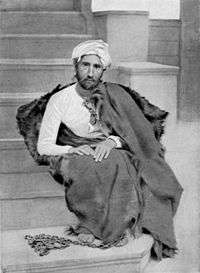Mirza Reza Kermani

Mirza Reza Kermani (in Persian: میرزارضا کرمانی), born in Kerman, Iran and died on August 10, 1896 in Tehran, was an adherent of Jamal al-Din al-Afghani and an Iranian revolutionary who assassinated the Shah of Persia Nasser-al-Din.[1]
Background
He and other followers of al-Afghani were demanding that the Qajar dynasty rule Iran justly. After al-Afghani was expelled from Iran by the Qajars, Kermani began to openly and publicly criticize Qajar officials. Eventually Kermani was imprisoned, his wife divorced him, and his son was made into a servant.[2]
Assassination of Nasser-al-Din Shah
On April 30, 1896, Kermani assassinated Nasser-al-Din Shah in the Shah Abdol Azim shrine.[3] According to Professor Nahid Pirnazar at UCLA, he is reported to have said "I had a chance to kill him (the Shah) before, but I didn't because the Jews were celebrating their picnic after the 8th day of Passover. I did not want the Jews to be accused of killing the Shah."(Habib Levy, Comprehensive History of the Jews of Iran, p. 397), {date=June 2009}. It is said that the revolver used to assassinate him was old and rusty, and had he worn a thicker overcoat, or been shot from a longer range, he would have survived the attempt on his life.[4] Shortly before dying the Shah is reported to have said "I will rule you differently if I survive!"
Capture and death

After killing the Shah, Mirza Reza Kermani escaped towards the border of the Ottoman Empire. Nasser-al-Din successor Mozaffar-al-din Shah sent a detachment of troops on camels to find Mirza Reza Kermani to avenge his father's death. He was captured at the Ottoman border. After months of interrogation, Kermani was executed on August 10, 1896 in order to be used as an example.
Consequences
Kermani's assassination of Nasser-al-Din Shah and the subsequent execution marked a turning point in Iranian political thought that would ultimately lead to the Iranian Constitutional Revolution during Mozzafar-al-Din Shah's turbulent reign; the Constitutional Revolution was the first major democratic movement in the modern Middle East.
References
- ↑ Dabashi, Hamid. Iran: A People Interrupted. Page 67. The New Press. Accessed 28-01-2008.
- ↑ Dabashi, Hamid. Iran: A People Interrupted. Page 68. The New Press. Accessed 28-01-2008.
- ↑ "Historical Personalities: Mirza Reza Kermani" Iran Chamber. Accessed 28-01-2008.
- ↑ Mo'ayeri (1982). Some notes from private life of Nasser al-Din Shah. Tehran: Nashr-e Tarikh-e Iran. p.105